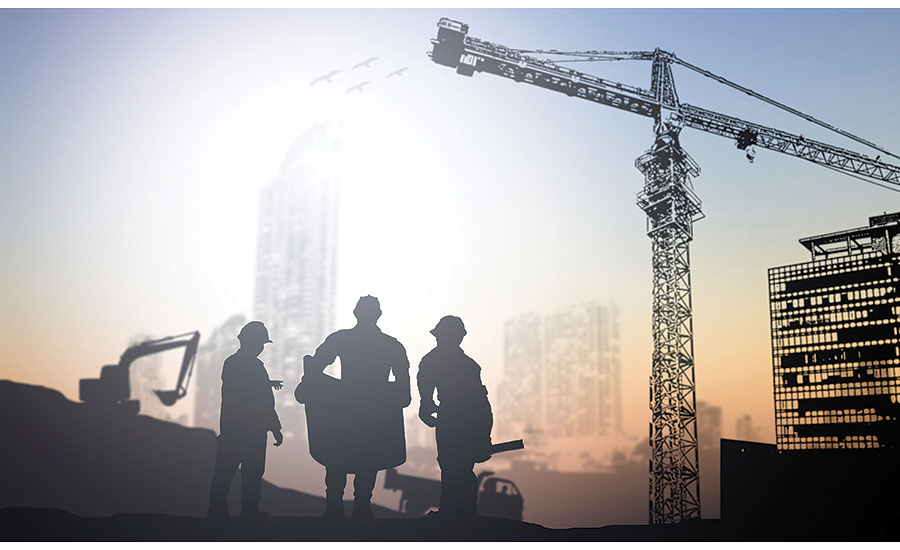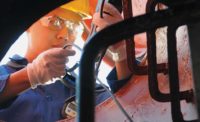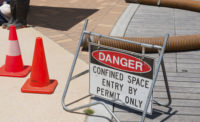On March 16, ISHN hosted a webinar on the new construction standard for confined spaces. Keller and Heckman partners Manesh Rath and David Sarvadi presented the webinar and answered questions from attendees. Some of our readers’ questions could not be answered within the time set aside. Manesh Rath and David Sarvadi address them in this article.
When can the confined space standard apply to an excavation?
A confined space is any place that is large enough for an employee to enter and perform assigned work, but which is not designed for continuous occupancy. A confined space has limited means of entry and exit. When a hazard exists that could affect an employees’ ability to perform the work or escape from the excavation, it could meet the definition of a confined space. Thus, each excavation needs to be evaluated using the definition provided for in the standard.
Where is it listed in the standard information regarding reclassifying a permit-required confined space (PRCS) to non-permit required confined space?
When there are any changes in the use or the configuration of a permit-required confined space, a competent person, as defined under the standard, may make a determination that all of the requirements have been met to reclassify the space. If the space poses no real or potential atmospheric hazards; hazards are eliminated or isolated, and the employer can document that fact; then the employer may reclassify that space. This is found in 29 C.F.R. § 1926.1203(g).
Who are permits filed with?
Employers are required to maintain records of permits. They do not need to be filed with OSHA.
Does the construction standard supercede EM 386-1-1 on an USACE construction site?
Supercede is perhaps not the correct word. A private employer is required to comply with all applicable standards under the Occupational Safety and Health Act. To the extent that another contractually-required standard conflicts, then the OSHA standard applies. If such requirements are not inconsistent with the OSHA standards, they may also be imposed by the host contractor. Thus, that private employer may also be contractually bound to other requirements such as EM 386-1-1.
Do utility companies fall under the new rule?
Yes, utility companies are subject to the requirements found in this new rule. OSHA has a compliance guide at https://www.osha.gov/Publications/OSHA3825.pdf that, for example, describes some related issues for sewer spaces.
How often should the attendant document monitor readings?
Conditions must be documented prior to entry. If entry is authorized, then under the construction confined spaces standard, the employer must perform continuous monitoring of entry conditions in the areas where authorized entrants are working. Where equipment for continuously monitoring an atmospheric hazard is not commercially available, or where periodic monitoring is of sufficient frequency to ensure that the atmospheric hazards are being controlled at safe levels. The compliance guide mentioned above has a sample program including an example of a permit.
How best to train employees on non-entry retrieval? Example: manholes - would we need to extract an actual person?
An employer may conduct training with the use of dummies that are available commercially and which simulate the extraction of a person through a narrow opening such as a manhole.
Are spotters needed in the construction standard? Are spotters part of “monitoring”?
Yes, the standard refers to these persons as “Attendants” and refers to a person who is stationed outside of a permit space and who is responsible for assessing the status of the entrants. The attendant will also often be responsible for performing a non-entry rescue or alerting rescue teams if an adverse event occurs. The standard describes the duties of the attendant in section 1926.1209.
An attendant must be trained to the same level as entrant?
Under the standard, each person must be trained for their respective duties. All affected employees must have training as to the hazards in a permit space, the methods used to isolate and control the hazard.
Each employer has to have a competent person...right? Does that competent person need to be continuously present?
A competent person is required to perform an initial assessment of the worksite. Whenever there are changes to a worksite, an employer must have a competent person re-evaluate that space. The language of the standard says “each employer must ensure that a competent person identifies. . . .” This languge does not explicitly require that every employer must have its own competent person, and could be interpreted to allow an employer to rely on the competent person employed by another employer on the site, or on a consultant hired by one or more contractors on a site. Regardless, each employer should be able to document that they can identify the competent person and that that person has evaluated any spaces that employer’s employees enter.
During new construction a confined space is created and identified, but is later filled in (making it not a confined space) during the construction project; does the controlling contractor need to report the previous existence and then removal of the confined space to the host employer?
A controlling employer must inform a host employer about permit space hazards. After entry operations, a controlling contractor must debrief each entity of any hazards. When entry operations have been completed, an entry employer may terminate the entry or cancel the entry permit, and must retain each canceled entry permit for at least one year. A space may be reclassified as a non-permit space when a competent person determines that the applicable requirements have been met to do so. From these requirements, we suggest that, when an employer eliminates a permit space, it makes sense to inform the controlling employer of this fact and the controlling employer may then notify other affected employers.
Have you heard anything of the attendant needing to be tied off on vertical entry?
Not specifically, but it would depend on whether the attendant is exposed to a fall hazard in the absence of other fall protection devices, such as guardrails. Obviously, in most circumstances, an authorized entrant must use a chest or full body harness, with a retrieval line attached. This is required for a non-rescue entry.
What is the maximum response time for outside rescue service?
The standard does not specify a maximum allowable response time for outside rescue services. OSHA discusses the response time and other considerations related to rescue services in the preamble beginning at page 25445. See the discussion at 25446 related to response times.


